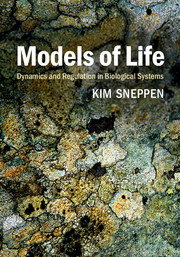Book contents
- Frontmatter
- Contents
- Preface
- 1 Life from a physics perspective
- 2 E. coli as a model system
- 3 Dynamics of regulatory links
- 4 Statistical mechanics of phage λ
- 5 Diffusion and randomness in transcription
- 6 Stochastic genes and persistent decisions
- 7 cis-Acting gene regulation and epigenetics
- 8 Feedback circuits
- 9 Networks
- 10 Signaling and metabolic networks
- 11 Agent-based models of signaling and selection
- 12 Competition and diversity
- 13 Evolution and extinction
- Appendix
- References
- Index
7 - cis-Acting gene regulation and epigenetics
Published online by Cambridge University Press: 05 October 2014
- Frontmatter
- Contents
- Preface
- 1 Life from a physics perspective
- 2 E. coli as a model system
- 3 Dynamics of regulatory links
- 4 Statistical mechanics of phage λ
- 5 Diffusion and randomness in transcription
- 6 Stochastic genes and persistent decisions
- 7 cis-Acting gene regulation and epigenetics
- 8 Feedback circuits
- 9 Networks
- 10 Signaling and metabolic networks
- 11 Agent-based models of signaling and selection
- 12 Competition and diversity
- 13 Evolution and extinction
- Appendix
- References
- Index
Summary
Nucleosomes and their enzymes
Previous chapters explored gene regulation where the regulator was produced from one gene, and subsequently diffused across the cell to bind to suitable binding sites at operators for other genes. This type of “trans”-acting gene regulation is commonly observed in both prokaryotes and eukaryotes. However, there exist other and more local mechanisms, allowing more fine-grained regulation. Such so-called “cis”-acting gene regulation involves proteins that influence regulation locally on the genome (see Fig. 7.1).
One example of such local regulation is the anti-terminator protein Q in phage λ, which mainly influences the phage genome where it is expressed [257, 258, 259]. The known examples of cis-acting gene regulation in prokaryotes is associated with regulators with very short lifetimes that bind either DNA or RNA, and thus the locality may rely on competition between effective diffusion time and decay time [259]. We will see that eukaryotes may instead use positive feedback as a powerful localization strategy.
Mechanisms for localized regulation of gene activity in eukaryotes include DNA methylation of CG sites [261, 262] and gene silencing by nucleosome modifications [263, 264, 265]. Interestingly, the nucleosome mediated gene silencing is so strong that it in itself can be used to sustain a genome in one of two bistable systems across many cell generations.
- Type
- Chapter
- Information
- Models of LifeDynamics and Regulation in Biological Systems, pp. 123 - 149Publisher: Cambridge University PressPrint publication year: 2014



